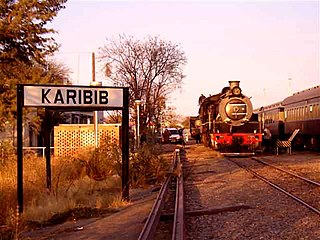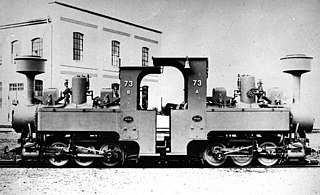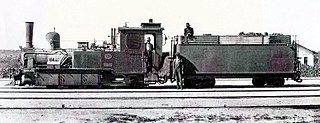This article deals with the system of transport in Namibia, both public and private.

Swakopmund is a city on the coast of western Namibia, 352 km (219 mi) west of the Namibian capital Windhoek via the B2 main road. It is the capital of the Erongo administrative district. As of 2011, the town had 44,725 inhabitants and 196 km2 (76 sq mi) of land. In 2023, the population had increased to 75,921 people.
The Trans-Kalahari Corridor is a paved highway corridor that provides a direct route from the port of Walvis Bay and Windhoek in central Namibia, through Botswana, to Pretoria in Gauteng province in South Africa. It initially cost approximately 850 million Namibian dollars and was officially opened in 1998.

TransNamib Holdings Limited, commonly referred to as TransNamib, is a state-owned railway company in Namibia. Organised as a holding company, it provides both rail and road freight services, as well as passenger rail services. Its headquarters are in the country’s capital Windhoek.

Tourism in Namibia is a major industry, contributing N$7.2 billion to the country's gross domestic product. Annually, over one million travelers visit Namibia, with roughly one in three coming from South Africa, then Germany and finally the United Kingdom, Italy and France. The country is among the prime destinations in Africa and is known for ecotourism which features Namibia's extensive wildlife.
The Otavi Mining and Railway Company was a railway and mining company in German South West Africa. It was founded on 6 April 1900 in Berlin with the Disconto-Gesellschaft and the South West Africa Company as major shareholders.

Okahandja railway station is a railway station serving the town of Okahandja in Namibia. It is part of the TransNamib Railway.

Karibib railway station is a railway station serving the town of Karibib in Namibia. It is part of the TransNamib Railway.

Swakopmund railway station is a railway station serving the town of Swakopmund in Namibia. It is part of the TransNamib railway network. Its IATA code is ZSZ.

Walvis Bay railway station is a railway station serving the port city of Walvis Bay in Namibia. It is part of the TransNamib railway network.

Keetmanshoop railway station is a railway station serving the town of Keetmanshoop in Namibia. It was erected in 1908. when the territory was colonised by Imperial Germany. It is part of the TransNamib Railway, and is located along the Windhoek to Upington line that was inaugurated in 1915 and connects Namibia with South Africa. Keetmanshoop also has a junction to Seeheim and Aus, completed in 1908.

Kranzberg railway station is a railway station in Namibia between the towns of Karibib and Usakos. It is part of the TransNamib Railway. At Kranzberg, the railway line from Windhoek splits; one line continues westwards to Swakopmund and Walvis Bay, the other one continues north-eastwards towards Omaruru and Tsumeb.

The South West African Zwillinge 0-6-0T of 1898 was a narrow gauge steam locomotive from the German South West Africa era.

The rail service in Namibia is provided by TransNamib. The Namibian rail network consists of 2,687 km of tracks (2017).

The history of rail transport in Namibia began with a small mining rail line at Cape Cross in 1895. The first major railway project was started in 1897 when the German Colonial Authority built the 600 mm gauge Staatsbahn from Swakopmund to Windhoek. By 1902 the line was completed.

Usakos railway station is a railway station in Namibia serving the city of Usakos. It is part of the TransNamib railway network. The station building is dilapidated but passenger trains still stop at Usakos.

The South West African 2-8-0T of 1907 was a steam locomotive from the German South West Africa era.
The Swakopmund–Windhoek line was a main 600 mm narrow-gauge railway line in Namibia. It was built in 1897 and operated until 1990 when the route name was changed.

The South West African Class Hb 0-6-2T of 1905 was a narrow gauge steam locomotive from the German South West Africa era.

The Walvis Bay 2-4-2T Hope of 1899 was a South African steam locomotive from the pre-Union era in the Cape of Good Hope.


















